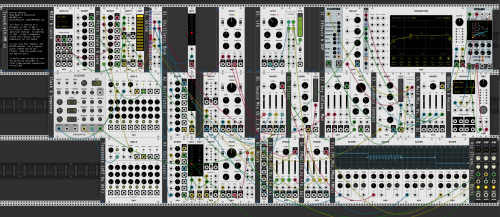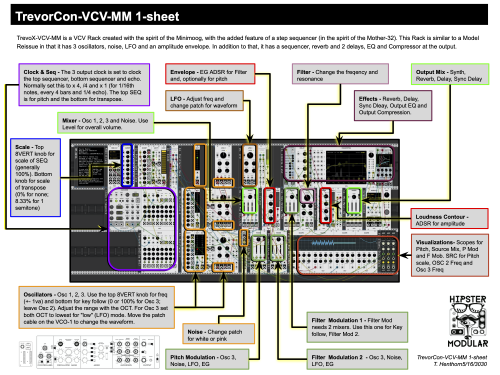TrevoX-VCV-MM
Overview
Part of the TrevoX series – Example (disambiguation)
TrevoX-VCV-MM is an eXample VCV Rack created with the spirit of the Minimoog, with the added feature of a step sequencer (in the spirit of the Mother-32).
This Rack is similar to a Model D Reissue in that it has 3 oscillators, noise, 2 envelopes, LFO and various modulation options. In addition to that, it has a sequencer, reverb and 2 delays, EQ and Compressor at the output.
It uses only VCV, Audible, and NYSTHI modules. For a lighter patch, remove the EQ and Effects. Take the output from the Amp Env VCA-2.
The Zip file shared on PatchStorage.com includes 7 example racks using the patch with different settings.
Quick Start
- Download the Zip file from PatchStorage.com
- Reset the Rack (See “Example 01” below).
- Try the other Rack examples – Fat Bass, Squelch Bass, Kick Drum, Square Lead.
- Turn the “knobs” – Osc 1/2/3, Noise, Filter Freq/Res, Filter Modulation (MIXER), Pitch Modulation (MIXER), Filter ADSR, Loudness ADSR
- Build Sequences – and transposition progressions
- Change Effects – and Master output EQ and Compression
- See the 1-Sheet – This diagram shows which parameters to tweak.
Research & Credit
I was inspired by the various attempts to recreate a Minimoog with VCV Rack. And, I want to thank these folks for the inspiration:
- Minimoog on VCV Rack (by core tan) Youtube
- Minimoog in VCV Rack (by Jack Nelson) Youtube
- Minimoog Model V (by balspect) https://patchstorage.com/minimoog-model-v/
- Minimoog Model D – Explained and Explored (by Rishabh Rajan) Ask.Audio Academy Video Course (also Youtube). The examples provided here are mirrors of Rishabh’s reset and examples.
Goals
The goals for this Rack were to:
- Recreate the spirit of the fixed architecture Minimoog (3 Oscillator synth with modulation options)
- Make a patch that just runs using VCV v1 modules wherever possible
- Make it playable with a sequencer
- Have reasonable ranges on the knobs (i.e. +- octave rather than 10v)
Example Patches
The Zip download includes these 7 Racks:
- TrevoX-VCV-MM-v1-01.vcv – Oscillator 1 saw, -1va below Middle C, no Filter
- TrevoX-VCV-MM-v1-02_Reset-Lite.vcv – Light version of the above (no Vis or FX). Also, the SL (“Glide”) has been removed.
- TrevoX-VCV-MM-v1-03-Fat_Bass.vcv
- TrevoX-VCV-MM-v1-04-Squelch_Bass.vcv
- TrevoX-VCV-MM-v1-05-Bass_Drum.vcv
- TrevoX-VCV-MM-v1-06-Square_Lead.vcv
- TrevoX-VCV-MM-v1-07-Sequence_with_Effects.vcv
Example 01. Basic patch with full reset
- Osc 1: -1va, saw, -3dB (on the source Mixer with Level -9dB)
- Osc 2: -1va, saw, -INF
- Osc 3: -1va, saw, -INF
- Noise: White, -INF
- Filter: Cutoff up (8372 Hz), Emphasis 0%
- Filter Modulation 1: all down, Level 0dB, Filter Modulation 2: all down except EG -3dB
- Pitch Modulation: all down
- Filter ADSR: 1ms, 1ms, 100%, 10ms
- Loudness ADSR: 1ms, 1ms, 100%, 10ms
*. 8VERT 1 (latch): 0
*. 8VERT 2 (pitch): 100, 8.33, 10
*. SL: Bypass
*. Clocked: x 1, / 4, x 1, 120 BPM, RUN off
*. Output Mixer: all down except IN 1 -3dB
Example 02. Reset – Light
This is the same as above but with Visualization and Effects removed. This patch only uses VCV modules and the Audible MUlTIPLES.
Example 03. Fat Bass
- 1. Osc 1: -1va, saw, -3dB
- Osc 2: -1va, saw, -6dB
- Osc 3: -1va, Pulse, -12dB
- Noise: White, -24dB
- Filter: Cutoff 120Hz, Emphasis 20%
- Filter Modulation 1: IN 2 -3dB
- Pitch Modulation: all down
- Filter ADSR: 1ms, 200ms, 50%, 10ms
- Loudness ADSR: 1ms, 600ms, 80%, 10ms
Example 04. Squelch Bass
- Osc 1: -1va, saw, -3dB
- Osc 2: -2va, saw, -12dB
- Osc 3: -2va, tri, -6dB
- Noise: White, -24dB
- Filter: Cutoff 120Hz, Emphasis 20%
- Filter Modulation 1: IN 2 0dB
- Pitch Modulation: all down
- Filter ADSR: 1ms, 200ms, 50%, 10ms
- Loudness ADSR: 1ms, 600ms, 80%, 10ms
Example 05. Kick Drum
Start with a reset Rack. One oscillator with noise and pitch modulation
- Osc 1: -2va, tri, -3dB
- Osc 2: off
- Osc 3: -2va, off
- Noise: White, -12dB
- Filter: Cutoff 120Hz, Emphasis 25%
- Filter Modulation 1: IN 2 -3dB
- Pitch Modulation: IN 3 -6dB
- Filter ADSR: 1ms, 10ms, 0%, 10ms
- Loudness ADSR: 1ms, 600ms, 0, 10ms
Example 06. Square Lead
- Osc 1: 0va, square, -3dB
- Osc 2: +1va, square, -6dB, up 1/5th
- Osc 3: +2va, square, -6dB, flat tuning
- Noise: White, -12dB
- Filter: Cutoff 500Hz, Emphasis 15%
- Filter Modulation 1: IN 2 -3dB
- Pitch Modulation: all down
- Filter ADSR: 1ms, 10ms, 0%, 10ms
- Loudness ADSR: 1ms, 600ms, 0, 800ms
- LFO: tri, 4Hz
Modules
The Rack uses the following:
- Qty 3 VCV VCO-1 – one for each oscillator
- Qty 4 VCV OCT – Range for each oscillator. Osc 3 gets two (to realize “low” mode)
- Qty 4 VCV 8VERT – Latch, Sequencer scale, Osc 2 and 3 frequency scale
- Qty 3 VCV UNITY – Mix of Seq and latch, mix of Osc 2 and 3 frequencing input
- Qty 4 VCV MIXER – Source Mix, Pitch Mod, Filter Mod and Main Output
- Qty 1 VCV VCF – Filter
- Qty 1 VCV NOIS – Noise
- Qty 2 VCV ADSR – Filter Contour (Envelope), Loudness Contour (Amplitude Envelope)
- VCV AUDIO-8 – Output
- Qty 2 Audible multiples – mult for Pitch & Gate, Osc 3 output
For overall audio improvement:
VCV DELAY, REC, PARAMETRA, NYSTHI PLATEVERB, 2FBE, DYNAMO
Option and Just for show (the patch will work without these):
- Qty 3 VCV SCOPE – Visualization of the source Mix, pitch modulation mixer
- Qty 2 ZZC SRC – a note visualizer for the output of the Osc 2 and OSc 3 8VERT knobs
Realization and Adjustment:
Finding the right knob to turn can be tricky. This instrument is best played with an external controller mapped to knobs. Follows are how the Minimoog knobs and switches were realized in VCV Rack.
A: Oscillator Bank
- Oscillator 1 – Range, Waveform – Use the OCT module for Range and switch the patch cable on the VCO-1 for the Waveform
- Oscillator 2 – Range, Waveform, Frequency – Use the OCT module for Range and switch the patch cable on the VCO-1 for the Waveform. The 8VERT is setup with the top knob adjusting +- 1 octave. It does this by routing to the 2nd knob (which should stay at 1/12 – 8.33%). The bottom knob of the 8VERT adjusts the range of the pitch. For OSC 2 leave this at 100%.
- Oscillator 3 – Range, Waveform, Frequency – same as Osc 2 except use the bottom knob of the 8VERT to turn off/on key follow (0% for off, 100% for on)
B: Mixer Section
- Mix Osc 1, 2, 3 and Noise – The MIXER module realizes the 4 Minimoog knobs
- Noise Generator – Use the patch cable on the NOIS module to switch between pink and white noise
*. External Input & Feedback – Not realized. Using straight feedback with this Rack is not interesting
C: Modifiers
- Filter Envelope – the ADSR module in the Filter section realizes the ADS knobs on the Minimoog
- Low Pass Filter – the Freq, Res and Freq CV knobs on the VCF module realize the 3 Minimoog filter knobs. The MIXER module combines the filter envelope with the pitch (for key tracking)
- Loudness Contour – the ADSR module in the Loudness section realizes the ADS knobs on the Minimoog
- Output Section – The MIXER module at the output is used for overall volume and for mixing in reverb and delay
*. Release Stage for Envelopes – On the Minimoog, there is a “Decay” switch. In this patch, just use the “R” knobs for release on the filter and loudness
D: Controllers
- Tune – Use the bottom knob on the first 8VERT to scale the tuning. Since the SEQ-3 outputs 0-10v, set the knob for 10% to adjust +- 1 octave
- Glide – The SL module has a bypass button (blue = “bypass”). Turn it off for glide. Then, adjust the attack/release for portamento effects
- Pitch Modulation – This is realized with a mixer. Mix Osc 3, Noise, LFO and the EG)
- Filter Modulation – This is realized with a mixer. Mix Osc 3, Noise, LFO and the EG)
- LFO & Filter EG – On the reissue, there is an LFO. For the LFO to control, say the Filter, you would set the MODULATION MIX knob, sswitch from NOISE to LFO and adjust the frequencer on the LFO knob. On my Rack, it’s in one place. The LFO-1 MODULE is mixed in with the Pitch and Filter MIXER modules. Switch between triangle and square by switching the patch cables on the LFO-1 output.
E. Optional Modules
- Scopes – Show Pitch (useful especially with the SL), Mixer (pre-filter and envelope), Pitch Mod, Filter Mod
- Note Display – the SRC modules show a note representation of the output of the Osc 2 and Osc 3 frequency adjustment.
- Effects and DSP – Reverb, Delay, Sync Delay, EQ and Compression. Set the sync for the delay using Clk3. These can be CPU hogs. Since they are looped through the output mixer, they can be safely deleted.
Differences from the Minimoog Reissue:
- Sequencer – The use of the sequencer changes the user interface. For example, the pitch range must be smaller to allow for adjustment via knobs. The 2nd 8VERT module is used for scaling.
Key tracking - Latch – for ease of sound design, the first 8VERT module is used to latch the key on. Turn the first knob to 100% and then adjust the Loudness Sustain to latch a note on. This can also be useful if you just want to remove note off entirely. For example, Latch a note and enable the SL for interesting smooth gliss.
- Clock – The 3 output clock is set to clock the top sequencer, bottom sequencer and echo. Normally set this to x 4, /4 and x 1 (for 1/16th notes, every 4 bars and 1/4 echo).
- The two Sequencers – The top sequencer is setup for 8 steps and a knob range of 1-octave. Only ROW 1 is used. The range can be changed with the bottom knob of the 2nd 8VERT (normally set to 10%). The bottom sequencer can be used for key changes. Use ROW 1 to transpose up by up to an octave. Use the top knob on the 2nd 8VERT to adjust the amount of transposition. Set to 10%. Leave the 2nd knob of the 2nd 8VERT on 8.33%.
- Switches vs Mixers – I’m not using any switch modules. This enables the Rack to be played entirely with knobs (and sliders).
- Note Priority – This is not relevant with the use of the sequencer
- Envelope Retrigger – Also, not relevant
- Modulation – OSC 3 or Filter EQ – not both, Noise or LFO – not both
Default Settings
Modules numbered left-to-right/top-to-bottom
8VERT 1 – Latch (top knob)
8VERT 2 – Pitch (top 2 knobs, bottom knob)
8VERT 3 – Osc 2 (top 2 knobs, bottom knob)
8VERT 4 – Osc 3 (top 2 knobs, bottom knob)
Mixer 1 – Source Mix
Mixer 2 – Filter Modulation 2
Mixer 3 – Main Mix
Mixer 4 – Pitch Modulation
Mixer 5 – Filter Modulation 1 (feeds into F Mod 2)
Sonification with the TrevoX-VCV-MM
TrevorX-VCV-MM was designed to be a general purpose instrument. The pitch input can be feed with other sequencer data, MIDI or CV recordings (say in the spirit of the TrevoCon-MMAF-C19-VCV patch).
CPU Metrics
This patch has been tested on the following
- 15″ Macbook Pro 2015i7 – works great
- MS Surface 6 – will test today
- Dell G5 – will test today
- Raspberry pi 4 – The patch opens but, sorry, even with the DSP removed, it still won’t run without glitches.
Downloads
- The VCV Rack and examples – Available on PatchStorage.com
Video
Coming soon.
Installation:
No externals are required to run this plugin. Open VCV Rack then load the TrevoX-VCV-MM rack. Press “Run” on the Sequencer.
View more patches in the TrevoX Series…



